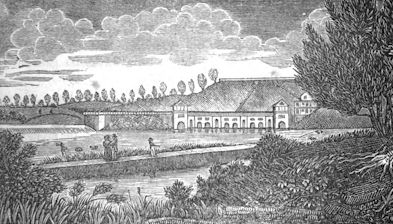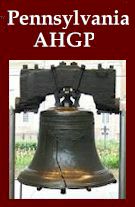City Improvements
The Water Works
The attention of the public to the necessity of a supply of pure
water, was invited by the venerable Franklin, and in his Will he
directed, that when the interest arising from a legacy, which he
left, for the benefit of young mechanics, amounted to a certain
sum, it should be applied to that important object. Repeated
attacks of an awful epidemic, a growing conviction in the public
mind, of the connection between the cleanliness of the city and
its health; of the utility of a copious supply of water, in
cases of fire, and for culinary purposes; and the deterioration
of our pump water, owing to the infiltration from the increasing
sources of impurities, becoming every year more perceptible, a
general sentiment prevailed, that some measures should be
pursued, to ensure an adequate supply.

Water Works |
In 1797 petitions, signed by an unprecedented number of
citizens, were presented to the City Councils, and their
attention, in consequence, was efficiently directed to the
object. Various schemes were proposed, and among them, the
formation of a reservoir, on the banks of the Schuylkill, but
after much deliberation the plan of Mr. Latrobe, which embraced
the erection of a marble building, at Centre (now Penn) Square,
with a reservoir, at an elevation of 50 feet, from the
foundation, and the establishment of two Steam Engines, adequate
to raise 3,000,000 gallons of water, every 24 hours, was
adopted.
Although the City Councils, in order to carry out the plan
proposed, created a loan of $150,000, and otherwise manifested a
proper spirit on the occasion, still from various causes, the
project was but coldly received, and the enterprise, not
actually commenced until May, 1799; with however, the aid of a
loan, from the Old Bank of the United States, the object was
actively pursued; and, on the 21st. of January, 1801, the first
water was thrown into the City, about one mile of pipes being
then laid down. A basin was formed at the Schuylkill, near the
permanent Bridge, 84 feet wide, and 200 long, which communicated
with the river, by an open canal, and was connected with a
subterraneous tunnel, six feet in diameter, and three hundred
feet long, to a shaft in a steam engine house, from which
situation the water was raised to a brick tunnel, six feet in
diameter, and one thousand, four hundred and eight yards long,
passing up Chesnut Street to Broad, and thence to the center
engine house, where the water was raised, by the steam engine,
to a reservoir, capable of holding sixteen thousand gallons.
The Steam Engines at Schuylkill and Centre Square, were wrought
with the best Virginia Coal, (our supplies of anthracite, at
that time being unknown) and were constructed, after the plan of
Bolton & Watt, with some improvement.
The pipes or tubes of wood, which were at first laid down, were
bored of a diameters, varying from 3 to 4 inches, and connected
at their joints, by cast iron cylinders, gradually sloped
towards each end, in order to produce a tight joint, when the
tubes were driven together. The length of tubes laid down in 181
1" exceeded thirty-five miles, and the quantity of water
supplied at that time, exceeded (daily) 700,000 gallons.
The marble building, at Centre Square, after the erection of the
present Water Works, at Fairmount, was occupied for several
years, as a Depository for Oil, employed in lighting the City,
it was removed about 8 years ago, and the Centre Square
converted into the four Squares, now known as Penn Square.
Fair Mount Water Works
As a source of convenience, health, and safety, the citizens of
Philadelphia cannot too highly estimate the present
establishment at Pair Mount, for watering the city. The erection
of a dam and the preparation of reservoirs, was commenced on the
19th of April, 1819. At the site of the dam, the river is about
nine hundred feet wide, one fourth of which, on the eastern side
is supposed to be a rock, covered with mud, and the remainder
rock. The greatest depth is 30 feet, at high water, gradually
growing shoal towards the western shore, where at the fall of
the tide, usually about six feet below the high water mark, the
rock is left bare. In consequence of the frequent occurrence of
sudden and violent freshets, it was necessary to construct a
dam, of great strength and place it in such a situation that it
would most effectually resist the greatest accumulation of water
in the Schuylkill. The dam rests on a foundation of cribs,
formed of large timbers, 50 feet in length, in the direction of
the river, and 18 feet wide, firmly secured in their situation,
by heavy stone, with which there are filled: these cribs are
firmly secured to each other, and support the planks and
timbers, which form the dam. The materials placed above the dam,
consisting of earth, stone, &c. form a base, with the wooden
structure, of at least 150 feet, gradually doping toward the
top, at which place it is narrowed to about 12 feet, and paved
three feet below the summit, with building stone, to guard it
from injury from ice, and washing by water. The whole length of
the dam, which runs in a diagonal direction, from the eastern to
the western shore, until it nearly reaches the latter and then
bends in an acute angle, running from the point to the western
shore presents a surface of over 1,600 feet, which, although the
structure has stood twenty years, yet displays the water
falling, in an almost unbroken sheet over its entire surface,
even at midsummer, when the Schuylkill has its lowest supply of
water, at which time it is computed that four hundred and forty
millions of gallons of water are afforded by the river, every
twenty-four hours, and it is estimated, (allowing for leakage,
waste, &c.) that forty gallons of water, acting upon the wheels,
will raise one gallon into the reservoirs at the summit, and it
follows from the calculation, that the reservoirs will afford a
supply of eleven millions of gallons of water (daily) in the
driest season of the year.
On the west side of the river, there are erected a head-pier,
and guard-locks, connected with a canal, 569 feet long, to two
chamber locks, of six feet lift each, by which the navigation of
the river is maintained, and the whole structure is guarded by a
wall, and blocks of stone, placed towards the river. In
constructing the eastern side, it was necessary to excavate
solid rock, to the extent of 140 feet, parallel with the river,
to form the site for the wheelhouses and other buildings, at the
base of Fair Mount. The length of the mill race is 410 feet, and
depth of excavation in its construction, varied from 16 to 60
feet, and caused an expense of over 910,000, for gunpowder, used
in blasting the solid rock.
At the upper part of the race is erected, three head-arches,
which form a continuation of the dam, to the rock of the bank.
On the vilest side of the race, which is about 90 feet in width,
the wheelhouses rest firmly on a solid rock, presenting
structures of stone, 238 feet long, by 66 feet wide. The lower
section is divided into twelve apartments, four of which are
intended, for eight forcing pumps, the others, for forebays, &c.
all of which are arched with brick, and perfectly secure from
the weather. These apartments have a gallery on one side, which
enables the spectators to see all the wheels at one view, and
they are kept warm in winter, to preserve the wheels clear of
ice. The wheels are made of wood, with shafts of iron, and are
very heavy and strong. The first wheel is capable of raising 1½
million of gallons of water, in 24 hours. The second, 1 1/3
million. The third 1½ million, and the others in the same ratio.
At the summit, five basins have been constructed, which
communicate with each other successively, affording an
opportunity for the water to deposit earthy impurities, before
it is transferred to the basin, communicating with the main
pipes leading to the city, and securing an ample, supply at all
times, in emergencies, from fire, and other causes.
The wooden pipes, at first laid down, have been (generally)
replaced with iron, and the extent of the latter, in the city
and surrounding districts, is so great that they, at all times,
contain a large body of pure water, in a state much cooler than
water in the reservoirs. The public wells, fireplugs, and
fountains are supplied from Fair Mount, manufactories,
breweries, public and private baths, and public and private
houses, are all supplied from the same source. The number of
bathing rooms, in private houses, exceeds 2,000.
No City in the United States, and perhaps, no one in any part of
the world, is better supplied with the inestimable blessing of
pure water, than Philadelphia, and many of our Atlantic cities
would estimate an establishment similar to that of Fair Mount,
could it be obtained, a cheap acquisition, at ten times its
actual cost to this city.
Philadelphia Post Office
This very extensive establishment is in the Exchange Building,
Corner of Third and Walnut Streets.
The Office is open Daily, (except Sundays) for the transaction
of business from sunrise, until 8 o'clock, in the Evening.
In conducting the business of the office, 23 clerks are employed
and 15 carriers are appointed, for the delivery of letters in
the city and all parts of the adjoining districts.
The annual revenue, in 1832, amounted to $125,000
In 1838, it had increase to $210,000.
The number of letters received, and forwarded daily averages
about 11,000. It is estimated that 20,000 packages newspapers
are daily deposited, for distribution.
James Page, Post Master. Philadelphia, June 19, 1839.
History of Philadelphia

|
![]()

![]()
